Disclaimer: all written below is based on my own limited experience. I have no intention to argue that I have full knowledge on anything. Not unlike Jon Snow, I also know nothing.
Before everything started or how I didn’t know what I was getting into
So there I was with my huge “backpacking” back pack filled to almost full capacity with comfortably ugly clothes I have deemed appropriate for the ten days of Vipassana Meditation Course I signed up for. The building I arrived at was a typical Indonesian house with white walls, a white floor and a terra cotta rooftop. The location was quite secluded and there was no sign of it being anything remarkable, making me worry that I have somehow reached the wrong place.
With every step I was taking, the voices in my head questioning my intention and motivation to do such an extreme Meditation Course grew louder. I had a strong urge to call it a day and leave the vicinity, believing that just reaching the door is already enough of an experience. But instead of following my impulses, I paid my taxi driver and went inside, looking for the weird people who are in charge of this program. Funny enough, the people I found in the building (there were three people to be exact), looked normal. They certainly did not look as weird as I expected them to be. Maybe being into meditation does not make a person weird, I concluded, or maybe the weirdness is so deeply hidden it doesn’t show at the surface.
Once I got someones attention, I asked him, whether I was at the right place, since there was no sign except for my GPS that said so. Despite being busy, a man wearing an old T-shirt (with its colours obviously lost due to lots of cleaning) answered with a quick smile that I was at the right place, and welcomed me to sit inside the big room that looked like a canteen. I put my huge backpack on the floor beside some bigger and smaller backpacks, wondering again if I over packed stuff, hoping that I would fit in with the other participants.
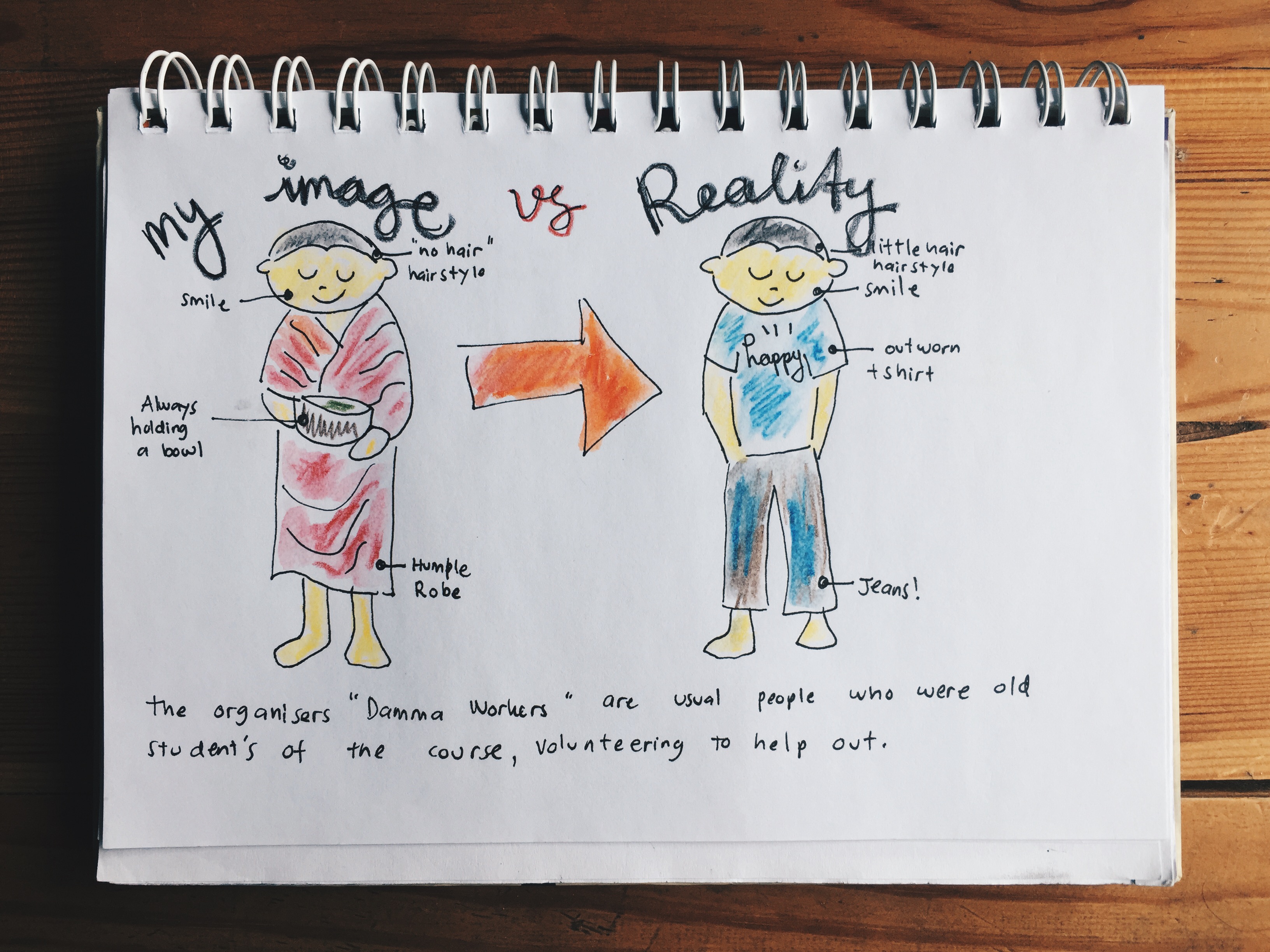 Image of people who are into meditation compared with reality
Image of people who are into meditation compared with reality
The Vipassana Meditation Course, if you are wondering at this point, is a ten day meditation course, in which participants are asked to 1) remain silent (literally not speaking to other participants), 2) put away their gadgets used to connect with the outside world, 3) put away books that might distract the internal process within oneself, 4) put away pen and paper that might be an external outlet to pour emotions and thought through the whole program and 5) do all this while staying inside the meditation complex. On top of that, after 12 pm each day, participants are also not allowed to eat “real” stuff (such as carbs, protein etc), and are only given a small serving of fruit and tea (and the occasional chocolate milk we will come to associate with all that’s good in life, but that comes later). Oh, I also must mention that we are asked to avoid eye and physical contact in any form with other fellow participants as much as possible (a complete description of the do’s and don’t’s on the course can be read here).
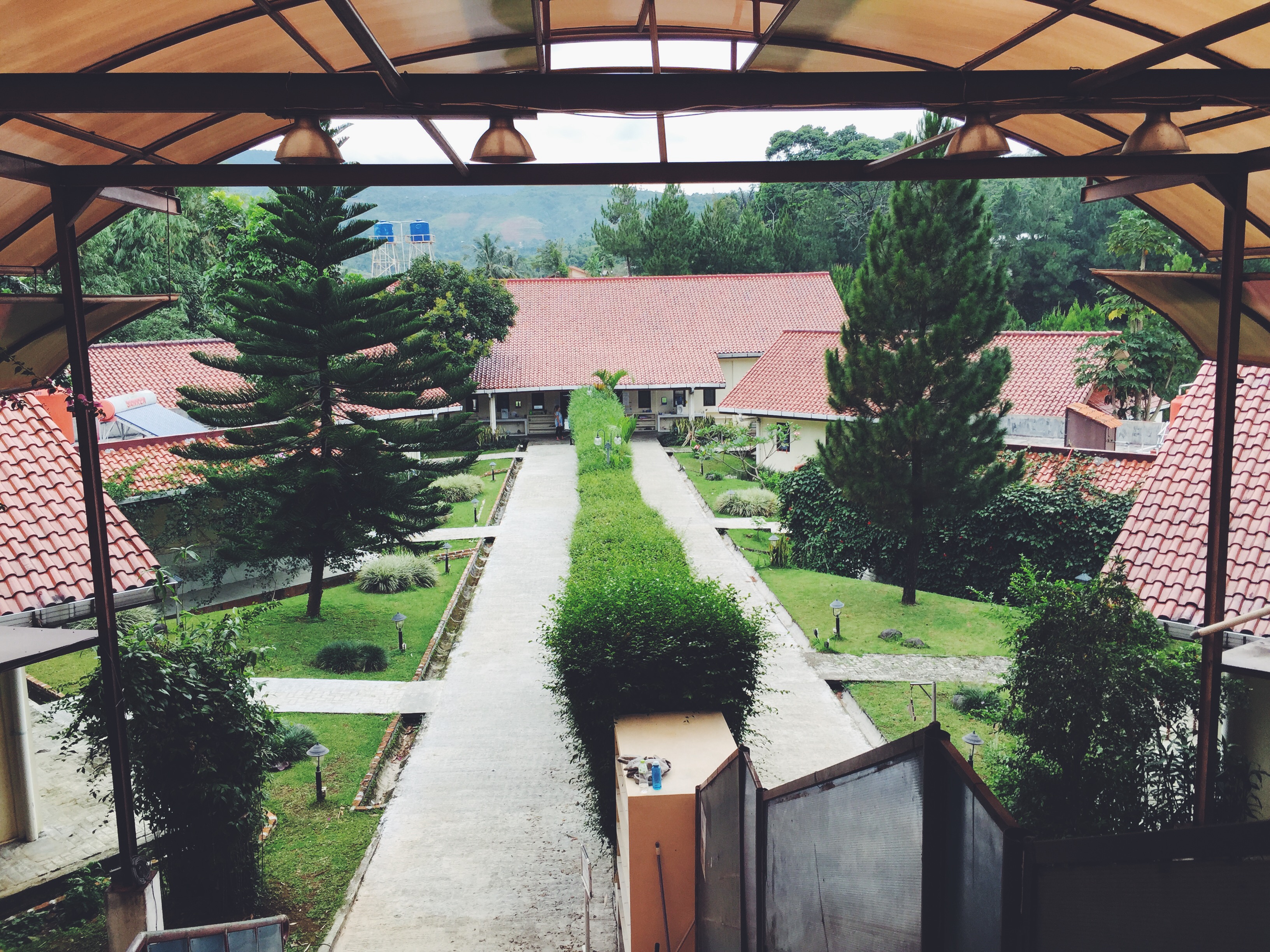
All these restrictions sound extreme, but to be honest, the no speaking policy especially was what drew me to the program in the first place. I was so curious whether I, an outspoken extroverted person (and occasional egomaniac), could possibly withstand the challenge of not talking to people for a whole 10 days. The silence part was also what I thought would be the most difficult part for me, but I was wrong since the course turned out to be more demanding than I thought. Of course I didn’t know that when I was sitting in the canteen that day, blissfully oblivious to the coming 10 days that awaited me.
The things I described above about the course were basically all I knew about it up to that point. I had no real conversation with anyone about their Vipassana experience before. But I did hear them say that it helped them live better, which to me was good enough given that the people who said so I deemed to be highly functional adults, something I aspire to be myself. At that point in my life (you know the 10 days felt so long that there was considerable shift in perspective within myself that I feel I should refer to it as “that time”, as if it happened a decade ago or so), I wanted to explore who I was and figured that the silence would help me understand what I wanted in life, the usual suspects of an adult in the midst of their quarter-life crisis.
–An excerpt from the movie Garden State (2004), a movie that beautifully shows the confusion of a quarter-life crisis. In this particular scene Zach Braff’s character described his feelings of loosing his idea of home after being away from home for a long time.–
The place I decided to do the Vipassana in was located in Bogor, around an hour into the mountains from Jakarta. I must mention here that there are hundreds of Vipassana centers all around the world, all practicing a standardised version of the Vipassana Course in different settings, the difference being in the shape of building and food they serve which will reflect the culture where the centre is. In this particular Vipassana centre, which is called Damma Java, there was one building with a canteen, three separate small houses turned dormitory for each gender, a whole building for our bathrooms (also for each gender), a big meditation hall, small meditation hall and a separate building for the teachers quarters and meditation cells.
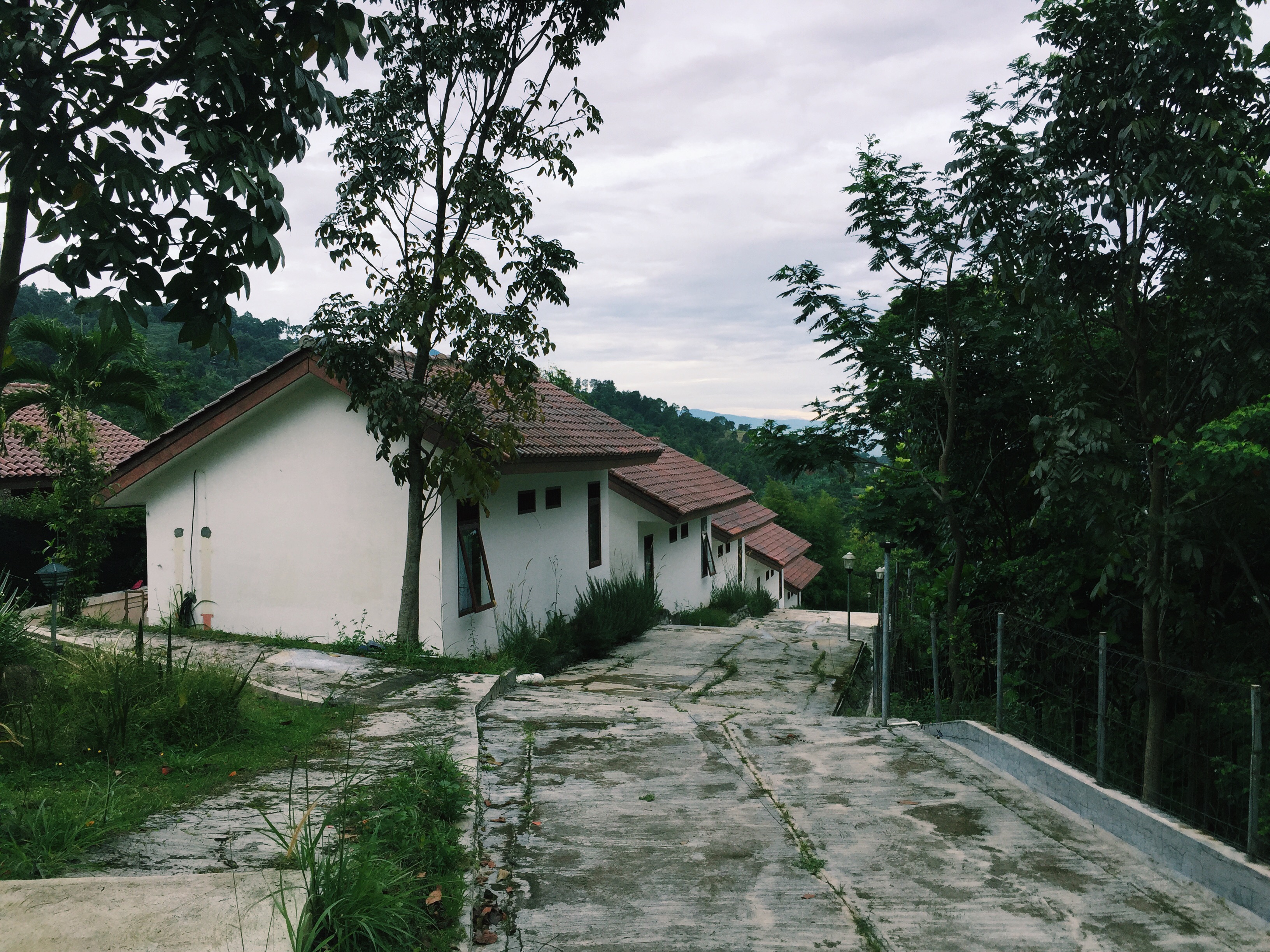
We had a lot of trees surrounding the area, and since it was located at the top of the hill overlooking what I assume to be Bogor City, it did look quite beautiful. But it was the type of beauty that was humble, not one that is overwhelming and demanding of our attention. Everything about this Vipassana centre screamed simplicity, something they might have designed on purpose as to not give us any space to go wonder outside ourselves, I later concluded.
Although the ten days will not start until the next day, even since the day before we were already asked to separate with our phone, books and pen, a separation that left me feel completely naked. At this point I realised I had no idea on what to do in a crowd of strangers without having my phone and book to hide behind.
After the worldly possessions were handed to the organisers, all the other participants (they were around 20 females and 20 males in total) started talking to each other especially about what they knew about Vipassana. It felt as if they were trying to say all the things they were not allowed to say to each other for the next ten days in this short period of time, while also alleviating themselves of their own worries on embarking on a course such as this. I, on the other hand, felt completely like a fish outside water, stuck in a particular kind of mood where I had no courage to talk to people I don’t know.
Peer pressure however made me brave myself and I dutifully went to the next table speaking to two wonderful ladies who are actually old students, having each done one and five courses of this before. I never actually thought there were people who would do such an extreme program more than once in life, so it was interesting to me that these ladies found the course so helpful for them that they would do it more than once, both said however that the course is also extremely challenging no matter how many times they did it. “After all,” one of them said, “In the course we are to meditate for 10.5 hours a day!”, a fact I never really thought of up to the point she said it. Now I really started to become nervous.
Not long after this conversation we were asked to meet our teacher in the Big Meditation Hall, to meditate with them for the first time, and after that session at exactly 8 pm that night, the Noble Silence Began. Everything from then on became extremely quiet. Only the sound of the constant wind and chirping birds were what accompanied me.
Not like myself I decided to have a shower before bed that night, mostly because I had no idea what to do with so much time on my hands in such silence and without any distractions. That night I rolled over restlessly in my single bed inside my private room of 2 x 3 square meter, looking up to the ceiling, feeling trapped in my own decision to do this weird course no one even knows of and missing my family so so dearly.
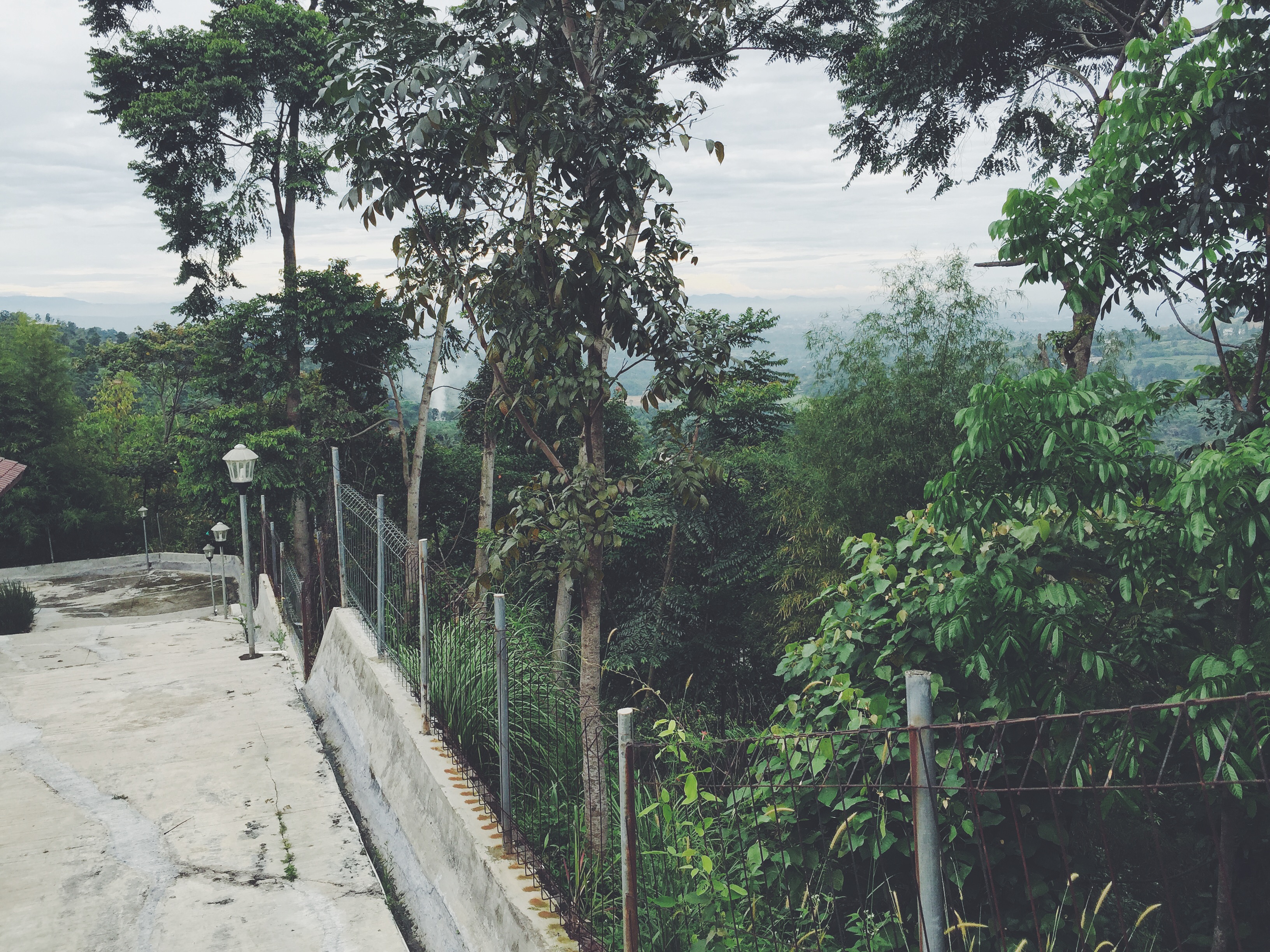
The first three days or better known as the intro to the real thing
The sound of the Bell woke me up at 4 am in the morning, just as promised. Half awake I went to brush my teeth and changed from my sleeping clothes. Despite not being allowed to look at the other participants, I still observed their movements, and seeing that all of the new students were clumsily also half awake, I felt better about myself (Note here on how used I am to judge myself compared with other people, something I really wish I could grow out of).
I walked rather zombie like to the Damma Hall, aiming directly at my seat, to participate in our first 4.30 am meditation session (full schedule of the days can be seen below). Inside the Damma Hall, we all got our own special meditation seat, which is basically a cushion we can sit on that is supposed to ease our meditation practice. If we still felt the need for it, we were also allowed to get as much pillows and cushions as we want to make us sit more comfortably. In the first few days it felt as if everyone was just busy with their pillows, trying desperately to find ways to make meditation more comfortable. Eventually we all realised that this is as good as it gets, no amount of pillow can ease our pain. We are also not allowed to move our seats without letting know the organisers (we are by the way, still allowed to talk to the organisers if we need some things for our survival, i.e. when we are sick etc, and also to our teachers to ask question about our meditation practice).
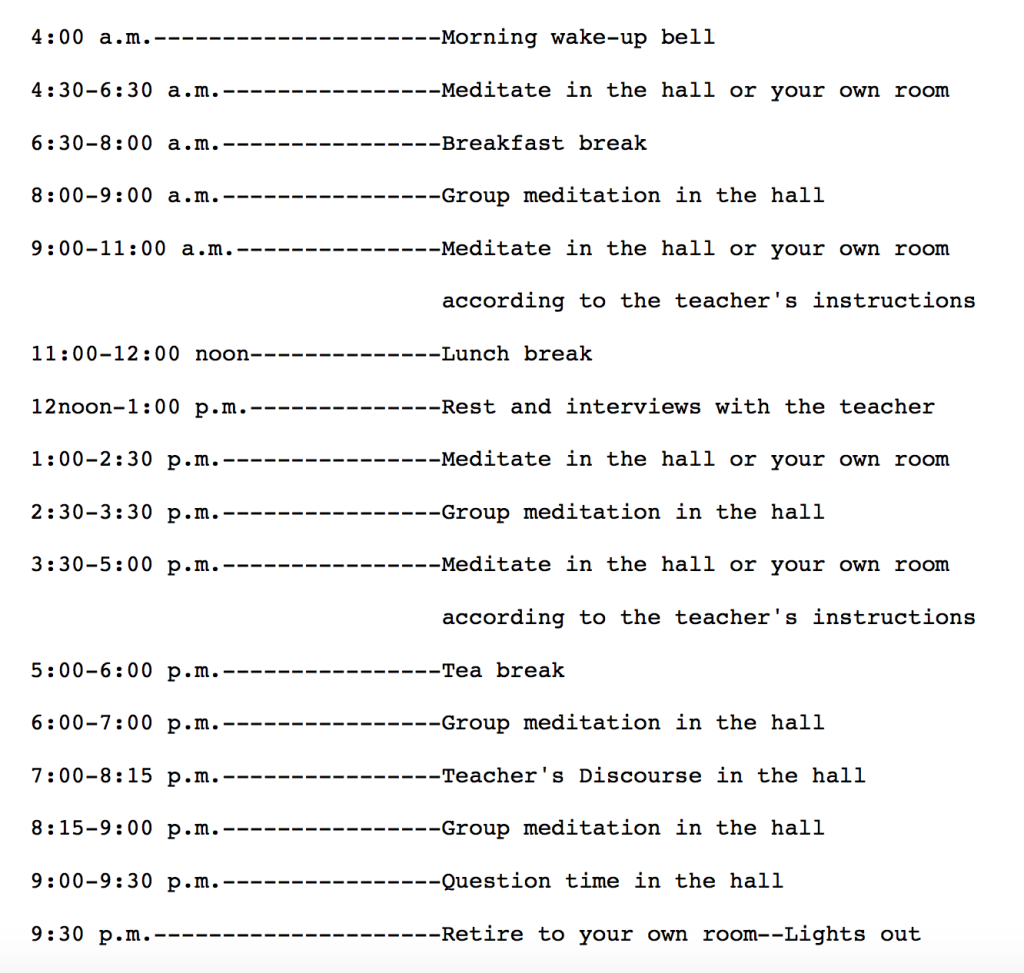
In that first day we learned about Anapana Meditation, this is a technique of paying attention to our breathing and then whenever we find our attention shifted by random thoughts (something that definitely will happen), we are to simply put our attention back into our breathing. Sounds simple enough right? The whole practice is about developing awareness, since most of the time when we start loosing our attention, we do not even realise it. So even if we only realised that we have started thinking about something completely different after a whole 20 minutes has passed, it is still ok. With practice, they tried to convince us, we will start having our attention back to our breathing even within 5 minutes. I had done such a practice before during my Yoga Practice, so I felt rather confident and was completely convinced that I have the whole course in my bag already.
But things really weren’t that easy. To do meditation for 10 minutes at a time is different with having it for an hour or even four hours at a time. My attention was wondering all over the place, having seemingly succeeded in both planning the next 5 years of my adult life and overviewing my whole life within a day. It doesnt help that for some reason my right shoulder, lower back and neck were not collaborating. I changed position probably every 5-10 minutes. No bliss in other words was felt that day.
Later on after the course I heard some of the men saying that for the first two days of the course he was just completely aware of his own saliva, not managing to get his attention away from having to swallow his own saliva. He was even already imagining how great it would be if he had a tool his dentist uses to suck away the saliva when operating oh his teeth. Funnily I had the same thoughts during my meditation, there is something about saliva laying in my mouth I couldn’t distract myself from especially 10 minutes into a meditation sitting.
The second and third day became slightly better, but I still felt both my back and right shoulder especially hurting during meditation time. In the mean time, the Anapana technique we learned became more refined, since not only were we to pay attention to our breathing, but also little by little we were encouraged to pay attention to the sensation we felt inside our nose when breathing, and later on even just the triangle area above our lips and below our nose (if you have no idea what I am talking about, welcome to the club, I had difficulty in imagining what that area was in the beginning too, since I never paid attention to it at all. So I started marking the triangle area with my saliva before every sitting, which I felt helped me understand where it is. I think this is called cheating.).
Although my body hurt, with time, as promised, it didn’t hurt as much anymore. With time I also felt like I could realise my wandering thought faster than when I started. Practice really improve capabilities I thought. I did however still had a slight worry in my head, since whenever I started “paying attention” to my breathing I started also to control it, although we were supposed to observe our natural breathing, but I really didn’t know what that meant. With full confidence however for those 3 days I tried to convince myself that I was doing the right thing, that there is no such thing as natural breathing and that controled breathing must be the only way we can observe our breathing. How would it even be possible to “observe” our breathing. It sounded absurd.
The end of the third day or my first break-down
On the discourse at the end of the third day however I learned that the next day would be the start of Vipassana. I was completely shocked, because I didn’t realise all the things we had been doing for the past three days was only an excercise, a prelude you may say, for the real thing. Despite trying to convince myself for the past three days that I can finish the course , it turned out knowing that all my struggles was not yet the “real” Vipassana felt severely hurtful to me. I started wondering if I could really see the finish line.
That night I decided to ask the teacher about my “breathing” situation. Hoping that she would tell me that I am doing the right thing, and that there is no such thing as a natural breath (despite it coming up in the teachings all the time). What she did tell me however was that my controlled breathing shows that I am not yet focused, since if I am completely focused on my breathing I would have not controlled it. We breath every moment of our lives, she continued, most of the time we don’t even realise it, it is this breath that we must observe.
I was dumb founded. This means that I have been practicing the past three days wrongly and that I would go to the next step (the real Vipassana) without actually having a real Anapana basis. My perfectionistic, competitive self completely freaked out.
As in real life I started cursing my own “confidence” for not asking the teacher earlier of my confusion, feeling strongly frustrated at how much I sucked at meditating and then naturally spiralling down into the feeling of despair on my whole life. And on top of that, this was not yet the real Vipassana, this was simply an intro! Oh how much I was hating myself at that point, only to be reminded on the next meditation sitting that to curse on the things we did in the past has no meaning. I am to focus again to the present. I am to focus on my breathing, my breathing is the present, only my breathing is what separates me from death, so I am to pay attention to it. So I did, or at least I tried my best to do so, doubting every step of the way.
It came naturally, at some point on the forth day, after I tried a trick the teacher told me. She told me to stop breathing until I have to breath. Then suddenly I was curiously able to observe my “natural breathing”. I was amazed. I didn’t know that my breathing would be this shallow (and sometimes deep), it was as if for the first time I actually met my “natural” self, however absurd I know this might sound. It was an accomplishment on my part, although the nagging in my head kept asking, “So What?”.
The Forth Day Onward or Finally Vipassana
We were introduced to the Vipassana technique after our lunch break on the fourth day. We were asked to keep our eyes closed while the teacher guided us to direct our attention to feel the sensation within our body starting from the top of our head, really slowly part by part to the tip of our toes. I felt a lot of things at once, most of which I can not explain. At times I felt like my head was dipped into water, at another time I felt as if it was being sucked up to the sky, and there were also times when I felt my head would explode due to the sensations, and all these different feelings kept circulating, kept changing.
I was completely hooked with Vipassana, and for the rest of the forth day, until the fifth day with full bliss I enjoyed exploring these pleasant feelings I was experiencing with my body. The feelings however started to go away, and I was left sitting with feeling nothing. Mind you, I could still feel the breeze of the wind, the changing temperature in my body, and of course pain coming and going at anytime. But that comfortable feeling I associated with Vipassana was not there anymore.
What Vipassana is or at least the short version of what I think it is
The idea of Vipassana is that suffering comes from our inability to accept impermanence. Or in more human language, we suffer because we can not accept that things change. When we feel sad, all we can do is worry for the sadness to pass, or to wish on a change of our situation, or to wish on a yesterday that somehow felt better. However the reality is that nothing is forever, sadness will pass. Also even during a really sad episode, things are not always sad. In other words, nothing lasts, and nothing is consistently always so.
–Yesterday, one of the most successful songs by the legendary Beatles. Probably the song was so successful (not to mention memorable) because everyone knows how it feels like to long for a yesterday that is no longer there. We are a species incapable it seems to live in the now.–
It is easy to talk about impermanence in terms of sadness and anger (and all other emotions we consider negative), but the truth also applies to happiness and love. When we are happy, fear starts creeping in, reminding us that we might loose everything. And that fear can turn people crazy. It can turn people to war to protect what they have, not fully accepting that change of circumstances is imminent, and fighting against it in many cases only brings in heartache. Talk about tragedy, it feels like we humans can’t win either way, even when we are happy our heads are capable into making it into a complete catastrophe.
–We all know how it feels like to not want a moment to pass, because we know that it might be the last moment we have with someone.–
So with Vipassana, we are to learn about the truth of impermanence through our body, the one tool that is equally available for everybody. The idea is that whenever you hear that things are impermanent, your intellect surely agrees with it, because the idea of impermanence is completely logical. But to agree with it on an intellectual basis and to actually live the idea of impermanence is completely different. Even when you understand the idea, it doesn’t help you live in the now, and it surely doesn’t help you accept truth.
So through Vipassana, when we are scanning our bodies for these so called “sensation”, we are taught to 1) acknowledge its existence, 2) not dwelling on it and 3) realise its impermanence. By acknowledging the existence of the sensation, whether it is pain or pleasant feelings, we are symbolically learning to not sweep it under the rug. This is especially important because sometimes we associate getting over our sadness or anger with forgetting it. But we should not forget or pretend that it is not there, rather we are to acknowledge it, and deal then let go of the misery that comes with it. This point I feel is perfectly described by Dalai Lama and Desmond Tutu in the video below.
Forgiveness is a strength“Forgiveness is the sign of strength” – Dalai Lama
Those who say forgiving is a sign of weakness haven’t tried it yet!
#ShareThejoy
#Bookofjoy
Are you in?
Posted by Desmond Tutu on Friday, October 7, 2016
Dalai Lama and Desmond Tutu, explain that forgiving does not mean forgetting.
But although we acknowledge the existence of any type of sensation whether good or bad, during the meditation we are encouraged to not dwell on it, and move forward to realise that other than that particular sensation, there are many other sensations happening in our body. Then also when we acknowledge and move on, once we return to feel that particular sensation, we can realise that it feels different then how it felt like when we last were there to feel it, or maybe the pain is even gone.
Meditation is also not just pain, sometimes there are twinkling pleasant feelings, that we end up craving. Just like what I felt during my meditation, when I can not feel pleasant sensation I became sad. But whether it is for good or bad sensations, to crave means that we are not accepting of the truth of impermanence. The truth for good and bad is the same, both are impermanent. With this, Vipassana tries to teach us about the impermanence of things.
The program tries to teach this rigorously, going as far as instilling a one hour “Sitting of Strong Determination/Adhitanna” three times a day for the last 5 days inside the Vipassana course. Inside this one hour, we were to practice Vipassana without moving our sitting position, hand position and opening our eyes. Its incredibly painful to do so, but our encounter with that pain is the time for us to practice of letting go. Even though all this sounds like a masochistic idea, I would like to point out why I am intrigued by it.
My conclusion after the course or Why I think Vipassana works
The thing is that we oftentimes are living in an illusion of association. We associate ourselves with many things, with our wealth, accomplishments, feelings, culture, and many other things a person can associate themselves with. But the thing is that we are not just all that. Without understanding this we risk falling into desperation whenever something that we associate ourselves with is gone. With vipassana, we learn to see ourselves from the outside, to see it as it is, without any judgement and interpretation as we usually do. And we do so with discipline trying to change our habit of falling into the trap of this illusion of association.
Vipassana therefore in a sense to me is a methodological approach to enlightenment. It has succeeded in directing all the elements needed to stop our circle of despair by trying to change our habits from the mind. It tries to help us see ourselves as it is, rather than what we think we should be or what we think we are not. The method is extremely kind, and somehow it fits well with many behavioural change theories I’ve read over the years.
But the question remains, does it really work?
Changing a habit that was built over the course of our entire live is extremely difficult, especially if the habit stems in the mind. Ten days surely does not change everything. What I did feel however was that all those questions I had in the beginning about my life and my future and what I should do, became irrelevant.
Through Vipassana I learned to see that there are things about life that is more than what I aspire to be. Aspiration and ambition pale with the sight of a person who has self control over their own live. Vipassana also gave me the confidence to know that with practice, I might truly change the habit of my mind. With practice I might truly be liberated.
For this realisation, ten days was surely not wasted.
